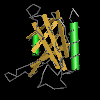?
 
Rho-associated coiled-coil containing protein kinase pleckstrin homology (PH) domain ROCK is a serine/threonine kinase that binds GTP-Rho. It consists of a kinase domain, a coiled coil region and a PH domain. The ROCK PH domain is interrupted by a C1 domain. ROCK plays a role in cellular functions, such as contraction, adhesion, migration, and proliferation and in the regulation of apoptosis. There are two ROCK isoforms, ROCK1 and ROCK2. In ROCK2 the Rho Binding Domain (RBD) and the PH domain work together in membrane localization with RBD receiving the RhoA signal and the PH domain receiving the phospholipid signal. PH domains have diverse functions, but in general are involved in targeting proteins to the appropriate cellular location or in the interaction with a binding partner. They share little sequence conservation, but all have a common fold, which is electrostatically polarized. Less than 10% of PH domains bind phosphoinositide phosphates (PIPs) with high affinity and specificity. PH domains are distinguished from other PIP-binding domains by their specific high-affinity binding to PIPs with two vicinal phosphate groups: PtdIns(3,4)P2, PtdIns(4,5)P2 or PtdIns(3,4,5)P3 which results in targeting some PH domain proteins to the plasma membrane. A few display strong specificity in lipid binding. Any specificity is usually determined by loop regions or insertions in the N-terminus of the domain, which are not conserved across all PH domains. PH domains are found in cellular signaling proteins such as serine/threonine kinase, tyrosine kinases, regulators of G-proteins, endocytotic GTPases, adaptors, as well as cytoskeletal associated molecules and in lipid associated enzymes. |
